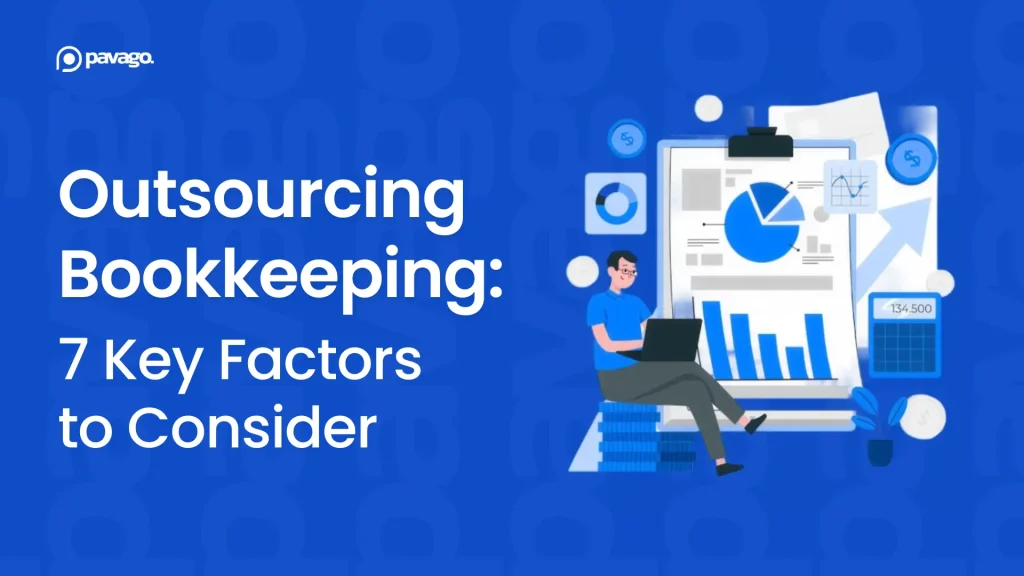If you’ve landed here, chances are you’ve already decided to outsource bookkeeping for your business. The math is compelling – potential cost savings of 50-70%, access to specialized expertise, and the ability to focus your internal team on strategic finance work rather than data entry.
The question isn’t whether to outsource anymore – it’s how to do it right.
After helping 50+ companies build successful offshore finance teams, we’ve seen the same critical mistakes repeated again and again. The difference between a bookkeeping partnership that saves you 60% on costs while improving accuracy, and one that creates more headaches than your old in-house chaos, comes down to 7 key decisions most companies get wrong.
In this article, we’ll talk about what works when you outsource bookkeeping (and what doesn’t), to help you make the right decision and save you from costly mistakes.

1. The Real Cost Comparison Framework
Most companies focus on hourly rates when evaluating outsourced bookkeeping options.
That’s like buying a car based solely on the monthly payment – you’re missing the total picture that determines whether you’re getting value or getting burned.
Hidden Costs of Outsourcing Bookkeeping
When you outsource bookkeeping services, the real cost includes:
Setup and Integration Costs: Expect 20-40 hours of initial setup time for software access, training on your processes, and system integration. Budget $1,000-$3,000 for this phase, regardless of your ongoing hourly rate.
Management Overhead: You’ll spend 2-5 hours per week managing your outsourced bookkeeping team initially, tapering to 1-2 hours ongoing. Factor this into your internal cost calculation.
Quality Control Time: Plan for monthly reviews that take 1-3 hours, plus quarterly deep-dives requiring 4-6 hours of your controller or CFO’s time.
Technology and Security Costs: Additional software licenses, VPN access, and security tools typically add $50-$200 monthly per outsourced bookkeeper.
Total Cost of Ownership Calculator
Here’s how the numbers actually break down for a typical $5M revenue company:
| Setup | In-House | Local Outsourced | Offshore |
|---|---|---|---|
| Salary / Fees | $45,000–$65,000 | $36,000–$72,000 | $14,400–$36,000 |
| Benefits/Overhead | $15,500 | Included | Included |
| Setup & Integration | $2,000–$3,000 | $2,000–$3,000 | $2,000–$3,000 |
| Management Time | Included | $8,000–$12,000 | $12,000–$18,000 |
| Total | $63,500–$93,500 | $46,000–$87,000 | $28,400–$59,000 |
The key insight? Offshore bookkeeping saves 35-55% compared to in-house, but you need to account for the increased management requirements upfront.
2. Vetting Offshore Bookkeeping Talent
Finding quality offshore bookkeepers isn’t about posting on job boards and hoping for the best.
The talent exists – we’ve placed hundreds of exceptional offshore finance professionals – but identifying them requires a systematic approach.
Here’s how to do it right:
- Test their skills for real. Don’t just ask questions – have them actually do bookkeeping work using your software.
- Make sure they know your industry. Bookkeeping for a retail store is different from that of a tech company. Find someone who understands your business.
- Good communication matters. It’s not just about speaking English, but about asking questions and being clear.
- Check how they handle deadlines. You want someone reliable who can work on their own and stay accurate.
- Always check references. Talk to past employers to be sure they’re trustworthy.
Pavago can help you find pre-vetted offshore bookkeepers, making sure they are skilled, experienced, and ready to become a part of your team immediately.
3. Getting the Technology Setup Right
Most companies underestimate the technology side of offshore bookkeeping.
Do it wrong, and you’ll spend months troubleshooting access issues, security problems, and data sync errors. Do it right, and your offshore team becomes as seamless as an in-house hire.
To ensure a smooth start:
- Identify all the necessary tools: This includes your accounting software (QuickBooks, Xero, etc.), banking platforms, receipt management tools like Expensify, and communication channels such as Slack or email.
- Implement strong security measures: Establish VPN access, enable two-factor authentication, and assign role-based permissions so your bookkeeper only accesses what’s necessary.
- Conduct thorough testing before going live: Process sample transactions, verify integrations, and confirm that data backups function properly.
Although this process may take 2 to 3 weeks, investing time upfront will prevent significant issues down the road.

4. Choosing the Right Team Structure
Many companies make the mistake of hiring just one offshore bookkeeper and expecting them to handle everything. But in most cases, a small team works much better.
Here’s when to choose each option:
| Solo Bookkeeper | Small Team |
|---|---|
| If you have fewer than 200 transactions a month, a simple business model, strong internal oversight, and a tight budget, one bookkeeper can be enough. | If you process 500 or more transactions monthly, have multiple revenue streams or locations, or want to avoid gaps during vacations or sick days, a team is the way to go. |
A typical small team looks like this:
- Transaction Processor: Handles day-to-day data entry and basic tasks (about 20-25 hours per week).
- Senior Bookkeeper: Manages month-end closes, reconciliations, and complex transactions (10-15 hours per week).
- Part-Time Controller (Optional): Oversees quality, provides strategic input, and manages client communication (5-8 hours per week).
This structure usually costs 15-20% more than a solo bookkeeper but reduces errors significantly and provides much better coverage.
5. Tracking Key Metrics to Measure Success
To make sure your offshore bookkeeping team is performing well, focus on a few important numbers:
- Month-end close time: Aim to finish financial statements within 5 business days.
- Error rate: Keep mistakes below 0.5% of transactions.
- Response time: Your questions should be answered within 4 business hours.
- Cost per transaction: Watch this monthly to spot trends or issues.
- Proactive insights: Track how often your bookkeeper suggests improvements.
By keeping an eye on these, you’ll know if things are running smoothly and where you might need to adjust when you outsource bookkeeping.
6. Knowing When to Scale Your Team
As your business grows, your bookkeeping needs will too. Consider adding more team members when:
- Your monthly transactions increase by 50% or more.
- Month-end closing starts taking longer than 7 business days.
- You expand to new locations or business areas.
- You need extra services like payroll or financial analysis.
Add new team members one at a time to keep things manageable and ensure smooth integration.
Pavago can help you scale up your team anytime you want, hassle-free. With our unique membership model, you get unlimited placements for just $500 annually.
7. Common Mistakes and How to Fix Them
Even with the best plans, things can go sideways. Here are some frequent problems we’ve seen, and how to fix them fast:
Communication Breakdowns: When regular updates stop or questions go unanswered, things get messy.
Fix: Restart weekly check-in calls, even if everything seems fine.
Quality Drops After a While: Sometimes errors creep in after 6-12 months.
Fix: Schedule quarterly performance reviews and refresher training sessions.
Costs Start Creeping Up: Unexpected expenses pop up without clear reasons.
Fix: Track cost per transaction every month to spot inefficiencies early.
Tech Glitches Cause Delays: Access issues or software problems slow down work.
Fix: Invest time in upfront tech setup and regular audits to catch problems quickly.

Your Next Steps
- Calculate your true current costs using the framework in section 1
- Define your technology and security requirements based on section 3
- Decide on solo vs. team approach based on your transaction volume and complexity
- Set up success metrics before you start, not after problems arise
The difference between achieving success and frustration when you outsource bookkeeping comes down to implementation quality, not just finding good people.
Frequently Asked Questions about Outsourced Bookkeeping
1. What are the benefits of outsourcing bookkeeping?
When you outsource bookkeeping, you can save money, get access to specialized expertise, improve accuracy, and free up your internal team to focus on strategic finance tasks.
2. Is it safe to outsource bookkeeping?
Yes, reputable bookkeeping providers use secure systems, encryption, VPNs, and strict access controls to protect your financial data.
3. How much does outsourcing bookkeeping cost?
Costs vary depending on business size, volume of transactions, and whether you hire offshore or nearshore talent, but it’s generally more cost-effective than hiring full-time, in-house bookkeepers.
4. What tasks can be outsourced in bookkeeping?
Commonly outsourced tasks include transaction entry, bank reconciliation, accounts payable/receivable, financial statement preparation, and month-end closing.
5. How do I choose the right bookkeeping service to outsource to?
Look for providers with industry experience, verified references, strong security practices, and clear communication processes.
Wrapping It Up
Outsourcing your bookkeeping can really take a load off your shoulders — saving you money, cutting down errors, and freeing up your team to focus on the big-picture stuff.
But here’s the thing: it’s not just about finding the cheapest option or rushing to hire whoever’s available. It’s about making smart choices at every step.
From understanding the true costs to picking the right people, setting up your tech, building a solid team, keeping the lines of communication open, and tracking what really matters — these are the moves that turn your decision to outsource bookkeeping from a risk into a real advantage.
At Pavago, we’ve helped over 50 businesses get this right, and we know it’s worth doing it well.
If you want to avoid the common headaches and build a bookkeeping partnership that actually works for you, we’re here to help.
















